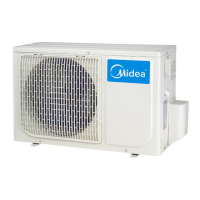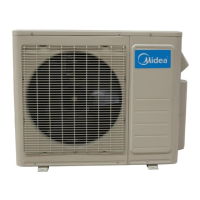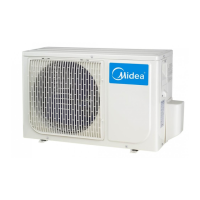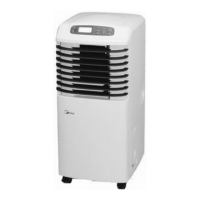● When refrigerant pipe diameter is different from that of outdoor unit union (for 18K&24K indoor unit),
additional transfer connector needs to be used on outdoor unit union.
Indoor unit
Extension pipe diameter (mm/inch)
Model Pipe diameter (mm/inch)
7K9K12K
Liquid 6.35(1/4) Liquid 6.35(1/4)
Gas 9.52(3/8) Gas 9.52(3/8)
18K
Liquid 6.35(1/4) Liquid 6.35(1/4)
Gas 12.7(1/2) Gas 12.7(1/2)
24K Liquid 9.52(3/8) Liquid 9.52(3/8)
Gas 15.9(5/8) Gas 15.9(5/8)
Outdoor unit union diameter (mm/inch)
1 drive 2
Liquid
6.35(1/4)
*2
Gas
9.52(3/8)
*2
1 drive 3
Liquid
6.35(1/4)
*3
Gas
9.52(3/8)
*3
1 drive 4
Liquid
6.35(1/4)
*4
Gas
9.52(3/8)
*3
12.7(1/2)
*
1
1 drive 5
Liquid
6.35(1/4)
*5
Gas
9.52(3/8)
*4
12.7(1/2)
*
1
8.4 Installation for the first time
Air and moisture in the refrigerant system have undesirable effects as below:
● Pressure in the system rises.
● Operating current rises.
● Cooling or heating efficiency drops.
● Moisture in the refrigerant circuit may freeze and block capillary tubing.
● Water may lead to corrosion of parts in the refrigerant system.
Therefore, the indoor units and the pipes between indoor and outdoor units must be leak tested and
evacuated to remove gas and moisture from the system.
Gas leak check (Soap water method):
Apply soap water or a liquid neutral detergent on the indoor unit connections or outdoor unit connections
by a soft brush to check for leakage of the connecting points of the piping. If bubbles come out, the pipes
have leakage.
1. Air purging with vacuum pump

